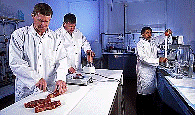United States Department of Agriculture: Agricultural Research Service, Lincoln, Nebraska

Roman L. Hruska U.S. Meat Animal Research Center: Reports
Date of this Version
1985
Document Type
Article
Abstract
Repeat-breeding females were classified as those females nonpregnant after two consecutive breeding seasons of 45 to 60 days' duration. Females were either naturally mated or artificially inseminated and exposed to clean-up bulls. Each year, approximately 7,000 beef females (6,803 to 7,374) at the Research Center were bred by either artificial insemination (approximately 2,000 females) and/or exposure to single or multiple sires in two breeding periods of 45 to 60 days' duration. Breeding periods were either May 15 to July 15 or November 1 to December 31 during 1979 through 1982. During the four years, 165 heifers and 241 cows (clinically free of diseases and 2 to 12 yr of age) of various straight and crossed breeds were classified as repeat breeders. Contemporary cows (102 head, clinically free of diseases and 3 to 11 yr of age) of various straight and crossed breeds, which produced a calf in the previous calving season, served as controls. Statistics on conception rate, calf survival, and number of repeat breeders are listed in Table 1. Total calf crop loss (28 pct average over four yr) resulted from 52 percent of the females being open (not pregnant) at palpation, while 48 percent of the females were pregnant but had prenatal (9.0 pct) and postnatal (39 pct) losses. The percentage of females classified as repeat breeders from the total females exposed was low (1.0 to 1.7). However, the percentage of females classified as repeat breeders from those females palpated nonpregnant averaged 10. Although repeat breeding was not a big problem in the Research Center herds, it may be a problem in other herds. Various causes and influences were investigated in the 406 repeat breeders in an attempt to determine if repeat breeding was due to one or several causes. Factors investigated in the beef cows and heifers were: previous calving difficulty in cows, fertilization failure, embryonic mortality, hormonal dysfunction, chromosomal abnormalities, and uterine secretions.


Comments
Published in Beef Research Program Progress Report (1985) No. 2: 49-51